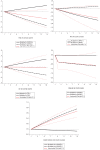A Statistical Investigation into the COVID-19 Outbreak Spread
- PMID: 36699646
- PMCID: PMC9868487
- DOI: 10.1177/11786302221147455
A Statistical Investigation into the COVID-19 Outbreak Spread
Abstract
Objective: Coronavirus-19 (COVID-19) outbreaks have been reported in a range of climates worldwide, including Bangladesh. There is less evidence of a link between the COVID-19 pandemic and climatic variables. This research article's purpose is to examine the relationship between COVID-19 outbreaks and climatic factors in Dhaka, Bangladesh.
Methods: The daily time series COVID-19 data used in this study span from May 1, 2020, to April 14, 2021, for the study area, Dhaka, Bangladesh. The Climatic factors included in this study were average temperature, particulate matter ( ), humidity, carbon emissions, and wind speed within the same timeframe and location. The strength and direction of the relationship between meteorological factors and COVID-19 positive cases are examined using the Spearman correlation. This study examines the asymmetric effect of climatic factors on the COVID-19 pandemic in Dhaka, Bangladesh, using the Nonlinear Autoregressive Distributed Lag (NARDL) model.
Results: COVID-19 widespread has a substantial positive association with wind speed (r = .781), temperature (r = .599), and carbon emissions (r = .309), whereas (r = -.178) has a negative relationship at the 1% level of significance. Furthermore, with a 1% change in temperature, the incidence of COVID-19 increased by 1.23% in the short run and 1.53% in the long run, with the remaining variables remaining constant. Similarly, in the short-term, humidity was not significantly related to the COVID-19 pandemic. However, in the long term, it increased 1.13% because of a 1% change in humidity. The changes in PM2.5 level and wind speed are significantly associated with COVID-19 new cases after adjusting population density and the human development index.
Keywords: Nonlinear autoregressive distributed lag (NARDL); Wald test; carbon emissions; coronavirus-19 (COVID-19); dynamic multiplier; particulate matter (PM2.5).
© The Author(s) 2023.
Conflict of interest statement
The author declared no potential conflicts of interest with respect to the research, authorship, and/or publication of this article.
Figures




Similar articles
-
The Nexus Between COVID-19 Factors and Air Pollution.Environ Health Insights. 2023 Apr 12;17:11786302231164288. doi: 10.1177/11786302231164288. eCollection 2023. Environ Health Insights. 2023. PMID: 37065166 Free PMC article.
-
Correlation of Dengue and Meteorological Factors in Bangladesh: A Public Health Concern.Int J Environ Res Public Health. 2023 Mar 15;20(6):5152. doi: 10.3390/ijerph20065152. Int J Environ Res Public Health. 2023. PMID: 36982061 Free PMC article.
-
Asymmetric Effects of Weather-Integrated Human Brucellosis Forecasting System Using a New Nonlinear Autoregressive Distributed Lag Model.Transbound Emerg Dis. 2024 Mar 5;2024:8381548. doi: 10.1155/2024/8381548. eCollection 2024. Transbound Emerg Dis. 2024. PMID: 40303170 Free PMC article.
-
Influences of climatic and non-climatic factors on COVID-19 outbreak: A review of existing literature.Environ Chall (Amst). 2021 Dec;5:100255. doi: 10.1016/j.envc.2021.100255. Epub 2021 Aug 24. Environ Chall (Amst). 2021. PMID: 36816836 Free PMC article. Review.
-
What are the Effects of Climate Variables on COVID-19 Pandemic? A Systematic Review and Current Update.Adv Biomed Res. 2023 Feb 25;12:33. doi: 10.4103/abr.abr_145_21. eCollection 2023. Adv Biomed Res. 2023. PMID: 37057247 Free PMC article. Review.
Cited by
-
Evaluation the frequencies of HLA alleles in moderate and severe COVID-19 patients in Iran: A molecular HLA typing study.Heliyon. 2024 Mar 26;10(7):e28528. doi: 10.1016/j.heliyon.2024.e28528. eCollection 2024 Apr 15. Heliyon. 2024. PMID: 38590857 Free PMC article.
-
The Nexus Between COVID-19 Factors and Air Pollution.Environ Health Insights. 2023 Apr 12;17:11786302231164288. doi: 10.1177/11786302231164288. eCollection 2023. Environ Health Insights. 2023. PMID: 37065166 Free PMC article.
References
-
- Suhaimi NF, Jalaludin J, Latif MT. Demystifying a possible relationship between COVID-19, air quality and meteorological factors: evidence from Kuala Lumpur, Malaysia. Aerosol Air Qual Res. 2020;20:1520-1529.
LinkOut - more resources
Full Text Sources
Miscellaneous

